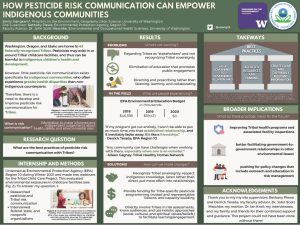How Pesticide Risk Communication Can Empower Indigenous Communities
Pesticides are often found in the air we breathe, the water we drink, and the soil children play in; thus, they are potentially present in Indigenous children’s environments. They can have harmful impacts to children’s health and development, ranging from conditions like vomiting and nausea to long-term effects such as cancer and neurological toxicity. Although risk communication plays a critical role in ensuring public health, very little pesticide risk communication exists specifically for Tribes, who often experience greater health disparities than their non-Indigenous counterparts. The purpose of this study was to determine the best practices of risk communication for pesticide use with Tribes to promote behavioral change. To accomplish this task, I performed extensive research and literature reviews that helped to develop two audience tailored webinars for the Environmental Protection Agency (EPA) Region 10, build pesticide background knowledge, identify environmental risk communication methodologies, and learn more about Indigenous communities’ experiences with risk assessments. This information was compared to interview responses surrounding working with Tribes and pesticide risk communication, sourced from 30-minute interviews with personnel working in federal, state, and nonprofit organizations. My findings demonstrate that best practices include recognizing the role of federal agencies in appreciating and maintaining cooperative government-to-government relationships with Tribes, allocation of resources for Tribal pesticide programs and staff, and developing clear and culturally specific communication for Tribes. Through these practices, we can improve Tribal health, better facilitate government-to-government relationships in environmental issues and push for policy changes that include outreach and education in risk management.
